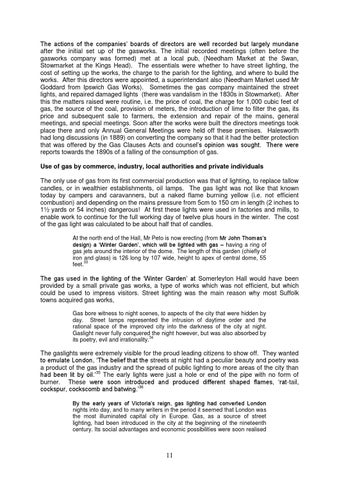The actions of the companies’ boards of directors are well recorded but largely mundane after the initial set up of the gasworks. The initial recorded meetings (often before the gasworks company was formed) met at a local pub, (Needham Market at the Swan, Stowmarket at the Kings Head). The essentials were whether to have street lighting, the cost of setting up the works, the charge to the parish for the lighting, and where to build the works. After this directors were appointed, a superintendant also (Needham Market used Mr Goddard from Ipswich Gas Works). Sometimes the gas company maintained the street lights, and repaired damaged lights (there was vandalism in the 1830s in Stowmarket). After this the matters raised were routine, i.e. the price of coal, the charge for 1,000 cubic feet of gas, the source of the coal, provision of meters, the introduction of lime to filter the gas, its price and subsequent sale to farmers, the extension and repair of the mains, general meetings, and special meetings. Soon after the works were built the directors meetings took place there and only Annual General Meetings were held off these premises. Halesworth had long discussions (in 1889) on converting the company so that it had the better protection that was offered by the Gas Clauses Acts and counsel’s opinion was sought. There were reports towards the 1890s of a falling of the consumption of gas. Use of gas by commerce, industry, local authorities and private individuals The only use of gas from its first commercial production was that of lighting, to replace tallow candles, or in wealthier establishments, oil lamps. The gas light was not like that known today by campers and caravanners, but a naked flame burning yellow (i.e. not efficient combustion) and depending on the mains pressure from 5cm to 150 cm in length (2 inches to 1½ yards or 54 inches) dangerous! At first these lights were used in factories and mills, to enable work to continue for the full working day of twelve plus hours in the winter. The cost of the gas light was calculated to be about half that of candles. At the north end of the Hall, Mr Peto is now erecting (from Mr John Thomas’s design) a ‘Winter Garden’, which will be lighted with gas – having a ring of gas jets around the interior of the dome. The length of this garden (chiefly of iron and glass) is 126 long by 107 wide, height to apex of central dome, 55 33 feet.
The gas used in the lighting of the ‘Winter Garden’ at Somerleyton Hall would have been provided by a small private gas works, a type of works which was not efficient, but which could be used to impress visitors. Street lighting was the main reason why most Suffolk towns acquired gas works, Gas bore witness to night scenes, to aspects of the city that were hidden by day. Street lamps represented the intrusion of daytime order and the rational space of the improved city into the darkness of the city at night. Gaslight never fully conquered the night however, but was also absorbed by 34 its poetry, evil and irrationality.
The gaslights were extremely visible for the proud leading citizens to show off. They wanted to emulate London, ‘The belief that the streets at night had a peculiar beauty and poetry was a product of the gas industry and the spread of public lighting to more areas of the city than had been lit by oil.’35 The early lights were just a hole or end of the pipe with no form of burner. These were soon introduced and produced different shaped flames, ‘rat-tail, cockspur, cockscomb and batwing.’36 By the early years of Victoria’s reign, gas lighting had converted London nights into day, and to many writers in the period it seemed that London was the most illuminated capital city in Europe. Gas, as a source of street lighting, had been introduced in the city at the beginning of the nineteenth century. Its social advantages and economic possibilities were soon realised
11
